

Next-Generation DMABUF How To Efficiently Play Back Video on Embedded Systems Embedded Linux Conference Europe Edinburgh, 2013-10-25 Lucas Stach <l.stach@pengutronix.de> Philipp Zabel <p.zabel@pengutronix.de> Slide 1 - http://www.pengutronix.de - 29.10.2013
Agenda ● Simple videoplayback using Gstreamer ● Adding hardwareunits in the mix ● DMA-BUF – why and how ● Current DMA-BUF flaws → our solution Slide 2 - http://www.pengutronix.de - 29.10.2013
Slide 3 - http://www.pengutronix.de - 29.10.2013
GStreamer software pipeline SW-Scaler DRM UVC Buffer Buffer Storage Storage Slide 4 - http://www.pengutronix.de - 29.10.2013
Now add another HW element Copy Copy HW-Scaler DRM UVC Buffer Buffer Buffer Buffer Storage Storage Storage Storage Slide 5 - http://www.pengutronix.de - 29.10.2013
Video4Linux UserPTR Copy pointer HW-Scaler DRM UVC Buffer Buffer Buffer Buffer Storage Storage Storage Slide 6 - http://www.pengutronix.de - 29.10.2013
Introducing DMABUF fd fd HW-Scaler DRM UVC Buffer Buffer Buffer Buffer Storage Storage Slide 7 - http://www.pengutronix.de - 29.10.2013
Fundamental DMABUF API struct dma_buf_attachment * dma_buf_attach ( struct dma_buf *dmabuf, struct device *dev); struct dma_buf_attachment { struct dma_buf *dmabuf; struct device *dev; struct list_head node; void *priv; }; void dma_buf_detach ( struct dma_buf *dmabuf, struct dma_buf_attachment *dmabuf_attach); Slide 8 - http://www.pengutronix.de - 29.10.2013
Fundamental DMABUF API struct sg_table * dma_buf_map_attachment ( struct dma_buf_attachment *, enum dma_data_direction); void dma_buf_unmap_attachment ( struct dma_buf_attachment *, struct sg_table *, enum dma_data_direction); Slide 9 - http://www.pengutronix.de - 29.10.2013
Sounds like a good idea and reasonably easy, but ... Slide 10 - http://www.pengutronix.de - 29.10.2013
Possible memory constraints ● different DMA windows ● contiguous vs. paged ● different MMU page sizes Slide 11 - http://www.pengutronix.de - 29.10.2013
Common restriction on embedded systems ● devices unable to do scather-gather DMA ● no IOMMU available → DMA memory needs to be physically contiguous Slide 12 - http://www.pengutronix.de - 29.10.2013
Mixed systems... fd HW-Scaler UVC Buffer Buffer scather-gather storage Slide 13 - http://www.pengutronix.de - 29.10.2013
Our solution Transparent backing store migration Slide 14 - http://www.pengutronix.de - 29.10.2013
Prerequisites ● drivers need to be able to describe their device's DMA capabilities ● commonly known: dma_mask ● there's more: struct device_dma_parameters { unsigned int min_segment_size ; unsigned int max_segment_size; unsigned long segment_boundary_mask; max_segments ; unsigned int }; Slide 15 - http://www.pengutronix.de - 29.10.2013
Prerequisites ● drivers need a more generic way for allocating backing store ● traditional DMA-API: void * dma_alloc_attrs ( struct device * dev, size_t size, dma_addr_t *dma_handle, gfp_t flag, struct dma_attrs * attrs) What's wrong with that? Slide 16 - http://www.pengutronix.de - 29.10.2013
Prerequisites ● new way to allocate DMA memory int arm_dma_alloc_sgtable ( struct device *dev, size_t size, struct sg_table *sgt, gfp_t gfp, struct device_dma_parameters *dma_parms); struct sg_table { struct scatterlist { unsigned long page_link; unsigned int length; dma_addr_t dma_address; } *sgl; unsigned int nents; }; Slide 17 - http://www.pengutronix.de - 29.10.2013
Prerequisites ● map for device with well-known DMA-API int dma_map_sg ( struct device *dev, struct scatterlist *sg, int nents, enum dma_data_direction dir, struct dma_attrs *attrs) ● map for CPU with new function void * dma_cpumap_sgtable ( struct device *dev, struct sg_table *sgt, pgprot_t prot); Slide 18 - http://www.pengutronix.de - 29.10.2013
Migration ● dma_buf_map_attachment ● current storage compatible with attachment? ● Yes → return sg_table ● No → wait for other maps to go away → reallocate storage Slide 19 - http://www.pengutronix.de - 29.10.2013
Reallocation ● try to find storage dma parameters compatible with all currently attached devices int dma_coalesce_constraints ( int num_parms, struct device_dma_parameters **in_parms, struct device_dma_parameters *out_parms) ● if not possible use parameters from device currently trying to map and exporter only ● last resort: parameters from mapping device only ● use parameters to alloc new storage Slide 20 - http://www.pengutronix.de - 29.10.2013
Migration ● dma_buf_map_attachment ● current storage compatible with attachment? ● Yes → return sg_table ● No → wait for other maps to go away → reallocate storage → move current content to new storage Slide 21 - http://www.pengutronix.de - 29.10.2013
Move buffer content ● simple and almost always working: ● map both buffers to CPU ● memmove() ● exporter is free to implement optimized move ● examples: ● GPU behind MMU can blit content ● usage of dedicated on-chip DMA engines Slide 22 - http://www.pengutronix.de - 29.10.2013
Migration ● dma_buf_map_attachment ● current storage compatible with attachment? ● Yes → return sg_table ● No → wait for other maps to go away → reallocate storage → move current content to new storage → return sg_table to new storage Slide 23 - http://www.pengutronix.de - 29.10.2013
Why isn't this dead slow? ● GStreamer reuses allocated buffers – and you should too Buffer Buffer Buffer Buffer Buffer Buffer HW-Scaler UVC Slide 24 - http://www.pengutronix.de - 29.10.2013
Corner cases ● sharing a buffer between devices with no overlap in device_dma_parameters → will work, but leads to ping-pong ● devices with memory not accessible to CPU and no way to migrate a buffer on it's own ● Do you know of any real world example? ● If you can't access a common memory region, why are you sharing a buffer? Slide 25 - http://www.pengutronix.de - 29.10.2013
Possible optimization ● Delay allocation to last possible point in time → alloc when first user wants to read/write ● Userspace hands buffer handle to all devices before starting the pipeline → all users attach before usage → exporter is able to allocate matching storage right from the start Slide 26 - http://www.pengutronix.de - 29.10.2013
Recommend
More recommend